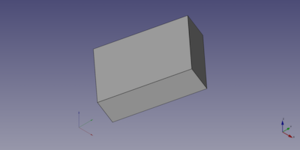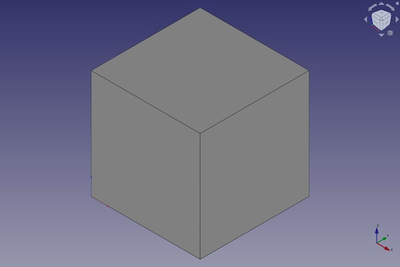Part Box: Difference between revisions
(New version of the Part Box wiki entry.) |
No edit summary |
||
| (30 intermediate revisions by 2 users not shown) | |||
| Line 1: | Line 1: | ||
<languages/> |
<languages/> |
||
{{UnfinishedDocu{{#translation:}}}} |
|||
<translate> |
<translate> |
||
| Line 24: | Line 23: | ||
<!--T:19--> |
<!--T:19--> |
||
The [[Image:Part_Box.svg|24px]] |
The [[Image:Part_Box.svg|24px]] '''Part Box''' command creates a parametric box solid, a [https://en.wikipedia.org/wiki/Cuboid#Rectangular_cuboid rectangular cuboid]. In the coordinate system defined by its {{PropertyData|Placement}} property, the bottom face of the box lies on the XY plane with its front left corner at the origin, and its front edge parallel to the X axis. |
||
FreeCAD creates a cube, each side with an equal length of 10 millimetre. |
|||
By default, the box is positioned with the lower left corner at the origin (0,0,0). The bottom of the cube is on the xy-plane. Its extension in x, y and z direction follows the positive axis values. |
|||
</translate> |
</translate> |
||
[[Image:Part_Box_Example. |
[[Image:Part_Box_Example.png|400px]] |
||
<translate> |
<translate> |
||
== Usage == <!--T:39--> |
== Usage == <!--T:39--> |
||
<!--T: |
<!--T:4--> |
||
| ⚫ | |||
First, make sure you are using the [[Image:Workbench_Part.svg|16px]] [[Part_Workbench|Part Workbench]]. |
|||
| ⚫ | |||
| ⚫ | |||
# The box is created. |
|||
# Optionally change the dimensions and {{PropertyData|Placement}} of the box by doing one of the following: |
|||
#* Double-click the object in the [[Tree_view|Tree view]]: |
|||
#*# The {{MenuCommand|Geometric Primitives}} task panel opens. |
|||
#*# Change one or more properties. |
|||
#*# The object is dynamically updated in the [[3D_view|3D view]]. |
|||
#*# Press the {{Button|OK}} button. |
|||
| ⚫ | |||
#* Change the {{PropertyData|Placement}} with the [[Image:Std_TransformManip.svg|16px]] [[Std_TransformManip|Std TransformManip]] command. |
|||
| ⚫ | |||
| ⚫ | |||
| ⚫ | |||
| ⚫ | |||
<!--T: |
<!--T:44--> |
||
| ⚫ | |||
To edit the Part Box: |
|||
* either |
|||
# select it in the tree and double-click on it |
|||
# edit the parameters in the appearing dialog |
|||
| ⚫ | |||
| ⚫ | |||
| ⚫ | |||
| ⚫ | |||
| ⚫ | |||
| ⚫ | |||
| ⚫ | |||
| ⚫ | |||
* A Part Box can also be created with the [[Image:Part_Primitives.svg|16px]] [[Part_Primitives|Part Primitives]] command. With that command you can specify the dimensions and placement at creation time. |
|||
| ⚫ | |||
The inserted box is a parametric, [http://en.wikipedia.org/wiki/Cuboid#Rectangular_cuboid rectangular cuboid]. |
|||
== Properties == <!--T:40--> |
== Properties == <!--T:40--> |
||
<!--T:48--> |
|||
See also: [[Property_editor|Property editor]]. |
See also: [[Property_editor|Property editor]]. |
||
<!--T:49--> |
|||
A Part Box object is derived from a [[Part_Feature|Part Feature]] object and inherits all its properties. It also has the following additional properties: |
A Part Box object is derived from a [[Part_Feature|Part Feature]] object and inherits all its properties. It also has the following additional properties: |
||
=== Data === |
=== Data === <!--T:50--> |
||
<!--T:51--> |
|||
{{TitleProperty|Attachment}} |
|||
<!--T:52--> |
|||
The object has the same attachment properties as a [[Part_Part2DObject#Data|Part Part2DObject]]. |
|||
<!--T:41--> |
<!--T:41--> |
||
| Line 72: | Line 78: | ||
<!--T:24--> |
<!--T:24--> |
||
* {{PropertyData|Length|Length}}: The length of the box. This is the dimension in |
* {{PropertyData|Length|Length}}: The length of the box. This is the dimension in its X direction. The default is {{Value|10mm}}. |
||
* {{PropertyData|Width|Length}}: The width of the box. This is the dimension in |
* {{PropertyData|Width|Length}}: The width of the box. This is the dimension in its Y direction. The default is {{Value|10mm}}. |
||
* {{PropertyData|Height|Length}}: The height of the box. This is |
* {{PropertyData|Height|Length}}: The height of the box. This is dimension in its Z direction. The default is {{Value|10mm}}. |
||
== Scripting == <!--T:42--> |
== Scripting == <!--T:42--> |
||
<!--T:53--> |
|||
See also: [https://freecad.github.io/SourceDoc/ Autogenerated API documentation], [[Part_scripting|Part scripting]] and [[FreeCAD_Scripting_Basics|FreeCAD Scripting Basics]]. |
|||
<!--T:26--> |
<!--T:26--> |
||
A Part Box |
A Part Box can be created with the {{Incode|addObject()}} method of the document: |
||
</translate> |
</translate> |
||
| Line 88: | Line 97: | ||
<!--T:27--> |
<!--T:27--> |
||
* Where {{Incode|myBox}} is the name for the object |
* Where {{Incode|"myBox"}} is the name for the object. |
||
* The function returns the newly created object. |
* The function returns the newly created object. |
||
<!--T:54--> |
|||
The {{Incode|Label}} is the user editable name for the object. It can be easily changed by |
|||
Example: |
|||
</translate> |
</translate> |
||
{{Code|code= |
{{Code|code= |
||
import FreeCAD as App |
|||
box.Label = "new myBoxName" |
|||
}} |
|||
<translate> |
|||
doc = App.activeDocument() |
|||
| ⚫ | |||
You can access and modify attributes of the {{Incode|box}} object. For example, you may wish to modify the length, width and height parameters. |
|||
box = doc.addObject("Part::Box", "myBox") |
|||
</translate> |
|||
{{Code|code= |
|||
box.Length = 4 |
box.Length = 4 |
||
box.Width = 8 |
box.Width = 8 |
||
box.Height = 12 |
box.Height = 12 |
||
| ⚫ | |||
doc.recompute() |
|||
}} |
}} |
||
<translate> |
<translate> |
||
| ⚫ | |||
You can change its placement with: |
|||
</translate> |
|||
{{Code|code= |
|||
| ⚫ | |||
}} |
|||
<translate> |
|||
<!--T:33--> |
<!--T:33--> |
||
| Line 130: | Line 131: | ||
</translate> |
</translate> |
||
{{ |
{{Part_Tools_navi{{#translation:}}}} |
||
{{Userdocnavi{{#translation:}}}} |
{{Userdocnavi{{#translation:}}}} |
||
Latest revision as of 20:53, 3 March 2022
|
|
| Menu location |
|---|
| Part → Primitives → Cube |
| Workbenches |
| Part |
| Default shortcut |
| None |
| Introduced in version |
| - |
| See also |
| Part Primitives |
Description
The Part Box command creates a parametric box solid, a rectangular cuboid. In the coordinate system defined by its DataPlacement property, the bottom face of the box lies on the XY plane with its front left corner at the origin, and its front edge parallel to the X axis.
Usage
- There are several ways to invoke the command:
- Press the
Part Box button.
- Select the Part → Primitives →
Cube option from the menu.
- Press the
- The box is created.
- Optionally change the dimensions and DataPlacement of the box by doing one of the following:
- Double-click the object in the Tree view:
- The Geometric Primitives task panel opens.
- Change one or more properties.
- The object is dynamically updated in the 3D view.
- Press the OK button.
- Change the properties in the Property editor.
- Change the DataPlacement with the
Std TransformManip command.
- Double-click the object in the Tree view:
Example

A Part Box object created with the scripting example below is shown here.
Notes
- A Part Box can also be created with the
Part Primitives command. With that command you can specify the dimensions and placement at creation time.
Properties
See also: Property editor.
A Part Box object is derived from a Part Feature object and inherits all its properties. It also has the following additional properties:
Data
Attachment
The object has the same attachment properties as a Part Part2DObject.
Box
- DataLength (
Length): The length of the box. This is the dimension in its X direction. The default is10mm. - DataWidth (
Length): The width of the box. This is the dimension in its Y direction. The default is10mm. - DataHeight (
Length): The height of the box. This is dimension in its Z direction. The default is10mm.
Scripting
See also: Autogenerated API documentation, Part scripting and FreeCAD Scripting Basics.
A Part Box can be created with the addObject() method of the document:
box = FreeCAD.ActiveDocument.addObject("Part::Box", "myBox")
- Where
"myBox"is the name for the object. - The function returns the newly created object.
Example:
import FreeCAD as App
doc = App.activeDocument()
box = doc.addObject("Part::Box", "myBox")
box.Length = 4
box.Width = 8
box.Height = 12
box.Placement = App.Placement(App.Vector(1, 2, 3), App.Rotation(75, 60, 30))
doc.recompute()
- Primitives: Box, Cylinder, Sphere, Cone, Torus, Tube, Create primitives, Shape builder
- Creation and modification: Extrude, Revolve, Mirror, Fillet, Chamfer, Make face from wires, Ruled Surface, Loft, Sweep, Section, Cross sections, 3D Offset, 2D Offset, Thickness, Projection on surface, Attachment
- Boolean: Make compound, Explode Compound, Compound Filter, Boolean, Cut, Fuse, Common, Connect, Embed, Cutout, Boolean fragments, Slice apart, Slice, XOR
- Measure: Measure Linear, Measure Angular, Measure Refresh, Clear All, Toggle All, Toggle 3D, Toggle Delta
- Getting started
- Installation: Download, Windows, Linux, Mac, Additional components, Docker, AppImage, Ubuntu Snap
- Basics: About FreeCAD, Interface, Mouse navigation, Selection methods, Object name, Preferences, Workbenches, Document structure, Properties, Help FreeCAD, Donate
- Help: Tutorials, Video tutorials
- Workbenches: Std Base, Arch, Assembly, CAM, Draft, FEM, Inspection, Mesh, OpenSCAD, Part, PartDesign, Points, Reverse Engineering, Robot, Sketcher, Spreadsheet, Surface, TechDraw, Test Framework
- Hubs: User hub, Power users hub, Developer hub
